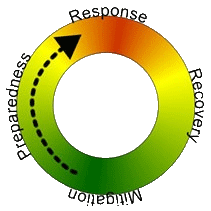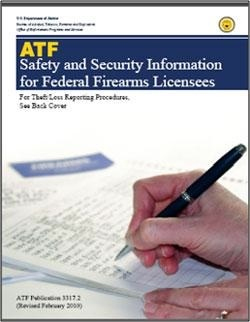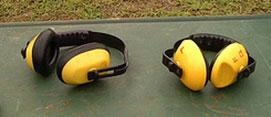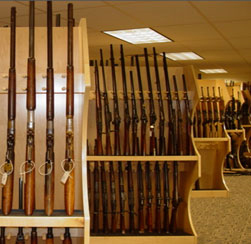Each year the Bureau of Alcohol, Tobacco, Firearms and Explosives (ATF) receives thousands of reports of theft or loss from federally licensed firearms dealers. There are many steps that you can take to diminish the risk of theft to your firearms business.
Structural Security
Business Hours Store Layout
Keep display cases locked unless an employee is displaying a firearm or other item from the case. Avoid displaying unsecured firearms within reach of customers, blind spots where customers can access inventory, or situations where all your employees either have their backs to the customers or leave the customers unattended.
After Hours Business Layout
Consider removing all firearms from display cases and racks and placing them in a gun vault at night or using reinforced display cases with shatterproof glass.
Door and Window Locks
Can any door or window be opened from the outside without keys? Do any former or non-employees have access to the keys? Are keys stored or kept near the container or door for which they are used? If any of your business keys have been lost or stolen, it may be time to replace, re-key, improve locks, and improve procedures for storing and tracking keys.
Windows and Doorjambs
Consider reinforcing or replacing windows/doors or investing in burglar bars or roll-down security gates on windows, doors, and vents. Barriers such as concrete filled posts may deter thieves who would consider using a vehicle to smash into the building to gain access. Consider replacing any exterior hollow core doors with solid metal or sheet metal faced solid wood doors.
Unsecured Openings
Air conditioning units in open windows, holes in exterior walls, chimneys, and other vents should be blocked or narrowed sufficiently to prevent entry.
Walls and Ceilings
Poorly protected adjoining businesses may provide an easy entry point for criminals who choose to go through unreinforced walls. A common precaution is to install floor-to-ceiling steel mesh in the gun vault and exterior walls. Can the roof of your establishment withstand an attempted break in? If circumstances warrant it, consider moving to a more secure building.
Exterior Lighting and Surrounding Structures, Shrubs, and Trees
Are there structures or objects such as dumpsters next to the building that may provide cover or easy access to the roof or windows? If possible, ensure that your business and the surrounding area are well lit at night and that there are no areas where criminals could conceal themselves to monitor your business or enter/leave the building unseen or after dark.
Front Windows and Entrance
Can employees see persons approaching the store or vehicles parked outside? Can a passersby see into the store or would a robbery go unnoticed?
Alarm System
Many States require an alarm system on specific firearms dealer establishments. If you have an alarm system, is it sufficient for your business and do you test the system on a regular basis? Are all points of entry protected? Do you have, or need, a panic button, tamper alarm, or cellular backup?
Protect Your Alarm Codes
Limit the number of people who know the codes. Change the codes on a regular basis and whenever there is employee turnover. Do not write/leave the codes where they are easily accessible to unauthorized persons.
Video Camera System
Video cameras on the premises should face in a direction that will capture people's faces and features. Recording systems should be protected from viewing, tampering, and/or theft and be recording at all times. If your recorder is a VCR, use fresh videotapes to avoid loss of integrity with repeated recording or consider switching to a digital recorder.
Answering Machine
Many States require an alarm system on specific firearms dealer establishments. If you have an alarm system, is it sufficient for your business and do you test the system on a regular basis? Are all points of entry protected? Do you have, or need, a panic button, tamper alarm, or cellular backup?
Disaster Preparedness
A disaster preparedness plan is a key to safeguarding your business, facilitating a quick recovery, and protecting the public from the potential theft/loss of firearms and ammunition. The following suggestions can help you plan for a possible disaster:
-
Create and maintain a current set of records (consider a second set maintained at a second secure location) that includes: insurance policies; supplier and contact list; computer records backup.

-
Create a list of employee phone numbers and give them a phone number so they can let you know they are OK in the event of a disaster.
-
Secure your inventory. Use safes and cable locks that can retain and protect inventory.
-
Perform a full inventory and take Acquisition and Disposition records to a safe location until the threat has passed.
-
Make your disaster plan "multi-hazard," appropriate for fire, tornado, hurricane, flooding, looting, etc
ATF can approve variances to move business operations (including National Firearms Act [NFA] firearms) in special circumstances, which can include impending natural disasters. For more information on disaster preparedness, see ATF Publication 3317.7, Disaster Preparedness for Federal Firearms Licensees.
Protecting Inventory
ATF recommends that Federal Firearms Licensees (FFL) take every precaution available to protect their firearms from theft or loss. This includes conducting periodic and thorough physical inventories and then reconciling the count to the book inventory. We highly recommend an annual inventory or its equivalent at a minimum. ATF has collaborated with the National Shooting Sports Foundation (NSSF) to promote Operation Secure Store, a comprehensive joint initiative to promote FFL safety and security measures to deter robberies and burglaries.
Firearms Missing from Inventory (Loss)
A "loss" of a firearm occurs when a licensee cannot determine the disposition/location of a firearm but there is no indication that it was stolen. In many instances, the licensee can determine the disposition of firearms by conducting a thorough inventory. If a complete inventory has been conducted, the FFL should conduct an exhaustive review of all acquisition and disposition records, shipping records, and if applicable all ATF Forms 4473. If the firearm cannot be accounted for, the licensee must report the loss to ATF.
Loss or Theft from Interstate Shipments
When an FFL receives shipments of firearms, it is a best practice to review the shipment to ensure that it contains all of the expected firearms and to record the acquisition immediately. An interstate "theft/loss" occurs when a firearm that was shipped through a common carrier including shipping/moving companies, and the U.S. Postal Service is lost or stolen while in transit. Regulations do not require you to report these incidents, but ATF strongly recommends it as a best business practice. ATF accepts voluntary reporting of the theft or loss of firearms from interstate shipments completed by a licensee or non-licensee and provides ATF Form 3310.6, Interstate Firearms Shipment Theft/Loss Report, to assist in reporting.
Report Theft or Loss of a Firearm
Lost or stolen firearms pose a threat to public safety. Licensed firearms dealers are the first line in maintaining the security and lawful transfer of firearms. Any FFL who has knowledge of the theft or loss of a firearm from their inventory must report the theft or loss, by telephone and in writing, within 48 hours of discovery to ATF and to the local law enforcement agency.
Upon discovery of any theft or loss of any of your firearms:
-
Call your local law enforcement agency to report the theft or loss. If the firearms are unaccounted for during inventory, you should make it clear to the authorities that there is no evidence of a crime and that the disposition of these firearms is unknown and may stem from a recordkeeping error.
-
Call the ATF's Stolen Firearms Program Manager toll free at 1-888-930-9275. They can also assist in the preparation of the Theft/Loss Report for submission. ATF will work with the local law enforcement authorities to investigate the theft.
-
Complete ATF Form 3310.11 and any necessary continuation sheets and mail the original form(s) to ATF's National Tracing Center. Retain copies for your records.
Basic Firearms Safety
Purchasers of firearms inherit the significant responsibility of protecting themselves and the public from the theft or loss of their firearms. Firearms dealers have an opportunity to help purchasers by providing information and products that can help them with this responsibility. 
To this end, firearms dealers should insist on complete firearms safety. Also, demonstrating safe firearms handling including clearing and unloading procedures gives customers the opportunity to learn these firearms safety procedures.
Federal law requires that firearms safety or locking devices be available for purchase and provided to anyone purchasing a firearm. We recommend that you advertise these items to your customers for storing their firearms. Advise customers to take their firearms directly home rather than leave the firearms in their vehicle while taking care of other errands. Remind your customers that firearms should always be unloaded when being stored.
For additional firearms safety and security information, see ATF Publication 3317.2, ATF Safety and Security Information for Federal Firearms Licensees
Firearms Handling and Storage
-
Treat every firearm as if it were loaded.

-
Always keep the muzzle of the firearm pointed in a safe direction.
-
Always keep your finger off the trigger and outside the trigger guard unless you intend to fire the weapon.
-
Wear appropriate ear and eye protection when discharging the firearm.
-
If there are children in the home, use child safety locks or other commercially available locking mechanisms on your firearms and/or keep your firearms locked in a secure location accessible to adults only. Keep your ammunition locked in a secure location away from the firearms.
-
Familiarize yourself with and obey all Federal, State, and local laws regarding the purchase, possession, carrying, use, storage, and disposition/sale of firearms.
Clearing/Unloading a Firearm
-
Always keep the muzzle pointed in a safe direction AND always keep your finger off the trigger and outside the trigger guard while cleaning or unloading a firearm. (Consider obtaining a commercially made firearm clearing barrel for safe clearing/unloading purposes.)
-
Remove the magazine or other source of ammunition.
-
Open the breech and visually as well as physically inspect the chamber to ensure the firearm is completely unloaded. Repeat this step twice to be sure the firearm is completely unloaded.



